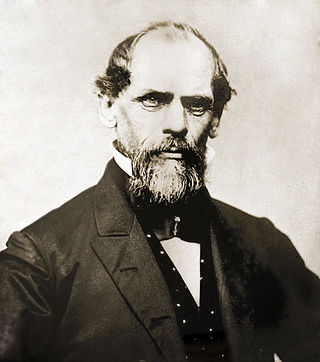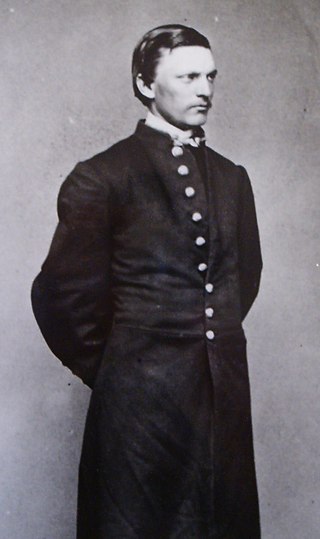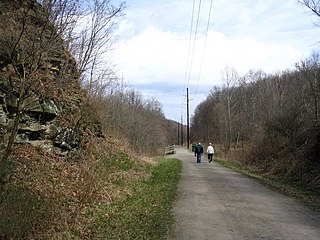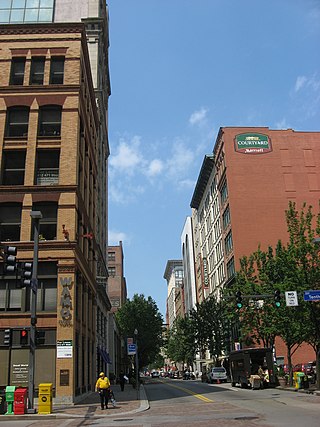
Saxonburg is a borough in Butler County, Pennsylvania, United States. It is part of the Greater Pittsburgh area in Western Pennsylvania. It was founded in 1832 by F. Carl Roebling and his younger brother John as a German farming colony. The population of Saxonburg was 1,525 as of the 2010 census.

John Augustus Roebling was a German-born American civil engineer. He designed and built wire rope suspension bridges, in particular the Brooklyn Bridge, which has been designated as a National Historic Landmark and a National Historic Civil Engineering Landmark.

The Allegheny Portage Railroad was the first railroad constructed through the Allegheny Mountains in central Pennsylvania. It operated from 1834 to 1854 as the first transportation infrastructure through the gaps of the Allegheny that connected the midwest to the eastern seaboard across the barrier range of the Allegheny Front. Approximately 36 miles (58 km) long overall, both ends connected to the Pennsylvania Canal, and the system was primarily used as a portage railway, hauling river boats and barges over the divide between the Ohio and the Susquehanna Rivers. Today, the remains of the railroad are preserved within the Allegheny Portage Railroad National Historic Site operated by the National Park Service.

Washington Augustus Roebling was an American civil engineer who supervised the construction of the Brooklyn Bridge, designed by his father John A. Roebling. He served in the Union Army during the American Civil War as an officer at the Battle of Gettysburg.

The Wheeling Suspension Bridge is a suspension bridge spanning the main channel of the Ohio River at Wheeling, West Virginia. It was the largest suspension bridge in the world from 1849 until 1851. Charles Ellet Jr. designed it and supervised construction of what became the first bridge to span a major river west of the Appalachian Mountains. It linked the eastern and western section of the National Road, and became especially strategically important during the American Civil War. Litigation in the United States Supreme Court concerning its obstruction of the new high steamboat smokestacks eventually cleared the way for other bridges, especially needed by expanding railroads. Because this bridge was designed during the horse-and-buggy era, 2-ton weight limits and vehicle separation requirements applied in later years until it was closed to automobile traffic in September 2019.

The Main Line of Public Works was a package of legislation passed by the Commonwealth of Pennsylvania in 1826 to establish a means of transporting freight between Philadelphia and Pittsburgh. It funded the construction of various long-proposed canal and road projects, mostly in southern Pennsylvania, that became a canal system and later added railroads. Built between 1826 and 1834, it established the Pennsylvania Canal System and the Allegheny Portage Railroad.

The Niagara Falls Suspension Bridge stood from 1855 to 1897 across the Niagara River and was the world's first working railway suspension bridge. It spanned 825 feet (251 m) and stood 2.5 miles (4.0 km) downstream of Niagara Falls, where it connected Niagara Falls, Ontario to Niagara Falls, New York. Trains used the upper of its two decks, while pedestrians and carriages used the lower. The bridge was the idea of Canadian politicians, and it was built by an American company and a Canadian company. It was most commonly called the Suspension Bridge, although other names included Niagara Railway Suspension Bridge, Niagara Suspension Bridge, and its official American name of the International Suspension Bridge.

Roebling's Delaware Aqueduct, also known as the Roebling Bridge, is the oldest existing wire suspension bridge in the United States. It runs 535 feet over the Delaware River, from Minisink Ford, New York, to Lackawaxen, Pennsylvania. Opened in 1849 as an aqueduct connecting two parts of the Delaware & Hudson Canal (D&H), it has since been converted to carry automotive traffic and pedestrians.
Minisink Ford is a hamlet on the Delaware River, fifteen miles northwest of Port Jervis. It is in the town of Highland, Sullivan County, New York, United States.

The Roberto Clemente Bridge, also known as the Sixth Street Bridge, spans the Allegheny River in downtown Pittsburgh, Pennsylvania, United States.

The Smithfield Street Bridge is a lenticular truss bridge crossing the Monongahela River in Pittsburgh, Pennsylvania, USA.

The Montour Trail is a multi-use recreational rail trail near Pittsburgh, Pennsylvania. It was formerly the Montour Railroad.

The Coraopolis Bridge[1] is a girder bridge over the back channel of the Ohio River connecting Grand Avenue on Neville Island to Ferree Street in Coraopolis, Pennsylvania. It opened in 1995 to replace a structure of historic significance. The original Pratt/Bowstring/Pennsylvania[2] through truss spans, designed by Theodore Cooper, were formerly the (third) Sixth Street Bridge, spanning the Allegheny River, in downtown Pittsburgh, and were built in 1892 by the Union Bridge Company. They were floated downstream by the Foundation Company in 1927 rather than being demolished when the bridge was removed to enable construction of the present (fourth) Three Sisters (Pittsburgh) Sixth Street Self-anchored suspension bridge. However, by the late 1980s, the old bridge could no longer support traffic volumes and was replaced by a newer structure.

The South Tenth Street Bridge, most often called the Tenth Street Bridge, but officially dubbed the Philip Murray Bridge, is a suspension bridge that spans the Monongahela River in Downtown Pittsburgh, Pennsylvania.
The Upper Delaware Scenic and Recreational River is a unit of the National Park Service designated under the National Wild and Scenic Rivers System. It stretches along 73.4 miles (118.1 km) of the Delaware River between Hancock, New York, and Sparrowbush, New York. It includes parts of Delaware County, Orange County, and Sullivan County in New York, as well as Pike County and Wayne County in Pennsylvania. Most of the land in this unit is privately owned; the federal government only owns about 30 acres (12 ha).

Barryville is a hamlet in Highland, Sullivan County, New York, United States. Previously known as "The River," the hamlet was renamed for William T. Barry, postmaster general under President Andrew Jackson.

Penn Avenue is a major arterial street in Pittsburgh and Wilkinsburg, in Pennsylvania. Its western terminus lies at Gateway Center in downtown Pittsburgh. For its westernmost ten blocks it serves as the core of the Cultural District with such attractions as Heinz Hall, the Benedum Center and the Byham Theater as well as the David L. Lawrence Convention Center and the Heinz History Center bordering it. Exiting downtown it is the major route through the city's Strip District, Lawrenceville, Bloomfield, Garfield and East Liberty neighborhoods. Its eastern portion exits the city at Wilkinsburg where it continues to exist as Penn Avenue with a numbering system that begins anew using small numbers as it approaches Interstate 376 the "Parkway East". Penn Avenue is about 8.7 miles (14.0 km) long.
The Pennsylvania Canal Tunnel was the Pittsburgh terminus of the Pennsylvania Main Line of Public Works, a transportation system that involved other early tunnels.

The Judge J. Frank Graff Bridge is an American truss bridge that carries U.S. Route 422 (US 422) and Pennsylvania Route 28 (PA 28) across the Allegheny River. It was named in honor of Frank Graff, an Armstrong County Court of Common Pleas Judge who later rose to become a member of the Pennsylvania Superior Court.
Pitt Township was one of the original townships created with the formation of Allegheny County, Pennsylvania, in 1788. It repeatedly diminished in size until dissolving into the city of Pittsburgh in 1868.
















